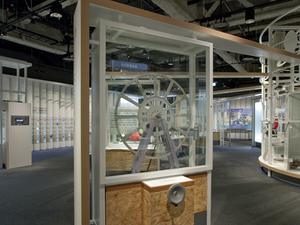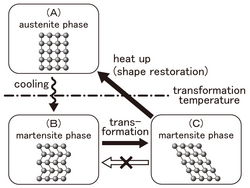Nagoya City Science Museum
TOP > Exhibition Guide > Keyword Search > Starting with "M" > Metal > Shape Memory Alloy
Shape Memory Alloy

Purpose of Exhibition
In this exhibition, you can play with a strange alloy which can memorize its original form. When you heat it with a warm wind, line-shaped metal will turn immediately into constellation-shaped.
If you transform it, the alloy that returns to its original shape over a certain temperature is called a "shape memory alloy". Shape memory alloy has played a vital role in items such as underwear (like a bra which does not lose its shape even if you wash it in a laundry machine), glasses frames, fishing tools, braces for teeth, pressure modification of rice kettles, pipes arms and so on.


Additional Knowledge
[Shape memory alloy]
Ordinary metals have been transformed by a large outside force and don't return to the original shape. However, even if it has been transformed, there are some alloys that return to the original memory alloy which are called "shape memory alloy". Over twenty kinds of "shape memory alloys" are known, and among them, nitinol (an alloy whose proportion of Nickel Ni and Titan Ti equals 1:1) is most widely used. When you change the proportion of a tiny little bit of nitinol and the temperature of the heat treatment, you can change the temperature in which the shape is recovered from 20 through to 100 degrees. If you mix a tiny little cobalt (Co), the temperature can go down to minus 30 degrees. The shape memory alloy exhibited will return to the original shape if the temperature is 35 through to 50 degrees.
[Device in which shape returns]
In this tiny little world of atoms, what's happening?The atoms of the metals are allotted regularly. In the case when you add the ordinary metals by force and transform it, the relationship of the neighboring atoms has now changed so that they have nothing to do with each other, and each one is connected to another atom. In this setting, it cannot return to its original shape. On the other hand, what happens to shape memory alloy atoms?First of all, you make shape memory alloy to be memorized, and treat with heat under the high temperature (400-500 degrees). At that time, the alloy is in the state of austenite phase (Figure A)". If it cools down rapidly, the temperature goes below a certain temperature (transformation temperature), and it will change to the state of martensite phase (Figure B). The connection of the atoms is allotted with a little slope. However, the appearance of the alloys does not change in either A or B. When the force applies and transforms it, the connection of the neighboring atoms will be kept, changing its shape. (B through C in Figure 1)When you heat C over the transformation temperature, the connection of the atoms is just the same and the alloys themselves return to their original shape.
[Super-elasticity]
By the way, shape memory alloy has some functions of not only "shape memory" but also "super-elasticity". The super-elasticity has the ability to return to the original shape when the transformed force is removed. In fact, the difference of these two is caused depending upon the difference of the temperatures in which the alloys return to the original shape.
The temperature in which the shape of alloys return is higher than inside and what it is necessary to heat is called "shape memory". On the other hand, when the temperature in which alloys return is lower, they immediately return to the original shape by means of the temperature inside and body temperature. It is called "super-elasticity". Among the examples given in the exhibition, there are a number of products that utilize the nature of super-elasticity.
Cooperation: Daido Steel Co., Ltd.
Article by Keiko Ishida, curator
